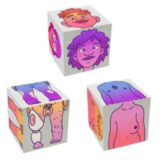CREATE A BODY
Click on the Body Dice App images to create a new body.
Alternatively, roll the paper dice or wooden dice.
Each of the three body parts has six different options.
Now address the child:
Look at the dice. What do you see?
Would you like to roll them again?
This already trains them in perceiving body diversity.
If the child asks for it, you can explain parts of the dice (see Body Knowledge).
If more children play on the dice app, observe their reactions and conversations.
Trains perception
PUT THE BODY INTO A PLACE
Address the child or group of children:
Imagine a place. It could be a beach, the woods or a shopping mal – anything you like.
What are you thinking of?
Now roll the dice. Who is this person?
Imagine that person in the place you thought of.
What are they doing? How does the person feel in this place?
Can you think of a story?
Trains creativity, empathy, critical thinking and verbal expression
RETELL THE TALE
Address the child or group of children:
Think of a tale you know. Which one do you think of? Who is the main person in it?
Now roll the dice. Retell the tale with the person in the dice as the tale’s main character.
You can change whatever you like about the other people or the story. For example, an evil wolf may
become a smart fox friend or Snow White might decide to live with the dwarfs instead of the prince.
Trains creativity, empathy and verbal expression
DRAW A BODY
Ask the child to only roll two dice instead of the three.
Now let them imagine what the missing body part could look like and invite them to draw it.
They can also draw an entire new body and explain it.
Trains creativity, concentration, artistic and verbal expression
BRING PEOPLE TOGETHER
For this game, you can join wooden dice, paper dice or the dice app on at least two digital devices.
Now ask the child or children to roll the dice and create at least two people.
Address the child or group of children: Who are they? What do they do?
Could these people have the same names although they have different bodies?
Could they go to the same school or work in the same job?
Think of the relationship between them. How do they know each other?
What do they like doing together? You can invent a story, if you like.
Trains creativity, critical thinking and empathy
TALK ABOUT THE BODIES
In a group, roll the dice and discuss some of these questions:
Who is this person?
What do you wonder when you see them?
How would you feel in their body?
Can this person walk? Do they hear? What is their profession?
Think of an activity. For this person, would it be easy or difficult to do?
Trains abstract thinking and empathy
IN ADDITION
When children tell stories about the bodies, you can, from time to time, ask questions about it.
When you ask a question, trust in the child to answer it and do not add pressure.
Children who do not (yet) write may feel especially valued when their story is written down.
It can also be fun to invent a song about their story.
